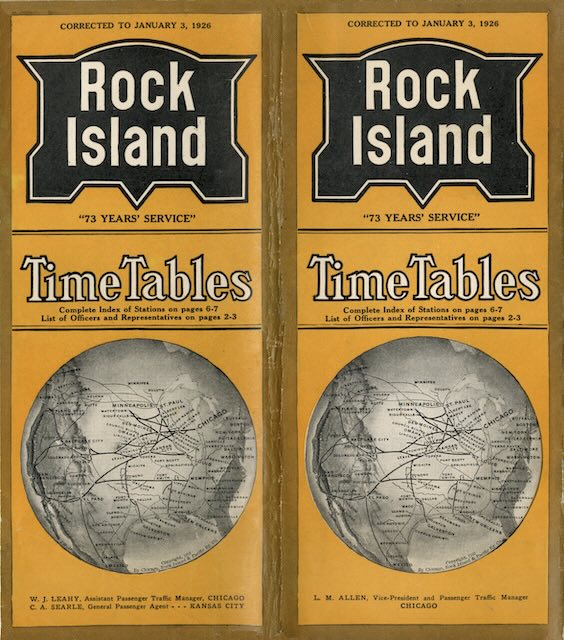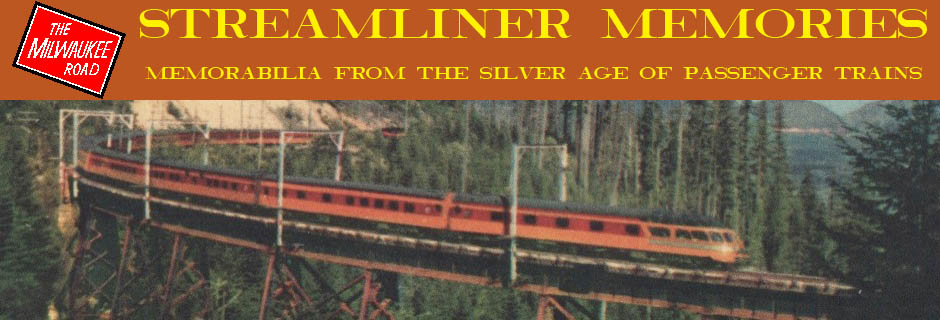Yesterday’s booklet mentioned a “new fast” but as yet unnamed Chicago-Los Angeles train that would be introduced on December 28, 1924, the same day as the Golden State Limited was reequipped with new cars. Actually, the “new” train was the old Golden State Limited, now renamed the Golden State Express. This timetable, which went into effect a year and six days after the new trains were introduced, shows that, while the Limited was still an all-Pullman train, the Express carried coaches and tourist sleepers. Unlike the new Limited (but like the old one), the Express didn’t offer shower baths, a ladies’ maid, or men’s barber/valet service.
 Click image to download a 29.3-MB PDF of this 40-page timetable.
Click image to download a 29.3-MB PDF of this 40-page timetable.
The Express also operated as a kind of advanced Limited. It left Chicago 2-1/2 hours before the Limited and arrived in Los Angeles a half-hour before. Eastbound, it left Los Angeles and arrived in Chicago an hour and 59 minutes before the Limited. Both trains required 68 hours minus one minute for their eastbound journeys, while westbound the Limited took 68-1/4 hours and the Express took 70-1/4 hours.
The Express also served as the connection with the Memphis-Californian, which connected Memphis, Little Rock, Oklahoma City, and Amarillo with California. The two trains met at Tucumcari, which meant they were merged or divided up at the same place where the trains were handed off between the Rock Island and Southern Pacific. Actually, according to this timetable, the only part of the Memphis-Californian that went to California was one sleeping car, though I imagine if demand was high more would be added.
As the railroad’s premiere train, the Golden State Limited should have been a “solid” train from Chicago to Los Angeles, meaning no delays for adding or deleting cars going on different routes. However, the timetable shows that St. Louis and Twin Cities cars were added/detached in Kansas City. Other cars were split from the train at Douglas to go to Phoenix and at Yuma to go to San Diego via Carriso Gorge.
In addition to the Memphis car, the Express also had sleeping cars to Dallas, Rock Island, St. Joseph, Phoenix, and the Twin Cities. All coaches went only from Chicago to Los Angeles so coach passengers going to any of these other destinations had to change trains.
The timetable shows a third transcontinental train, the Californian, going from Kansas City to Los Angeles. This was definitely a second-class train as it didn’t have an observation car and only offered dining car service east of El Paso. The train was scheduled to operate about 12 hours off the schedule of the Golden State Limited and thus was meant to serve communities that the Golden States only reached late at night. I believe that, before the Express was introduced, the Memphis-Californian connected with the Californian.
The Golden State Express didn’t last long. In 1926 or 1927 — reports differ — the name would be changed to Apache. Although the Californian would remain on the timetable until the beginning of the Depression, the Apache, like the Express before it, continued to serve as the connection with the Memphis-Californian.
The front cover of this timetable (the above image being the back cover) advertises the Memphis-Californian as providing “superior service” from Memphis to California. The ad also mentions the Choctaw Limited, which traveled the same route from Memphis but terminated in Amarillo, thus providing daytime service to communities that the Memphis-Californian reached only at night.
The timetable shows Rock Island had two trains a day between the Twin Cities and Kansas City (one of which connected with the Golden State Limited and the other the Express) and two a day between Kansas City and Dallas. For the sake of connections with the closely scheduled Limited and Express, these trains were not timed twelve hours apart from one another.
In the Denver corridor, however, Rock Island offered two trains, the Rocky Mountain Limited and Colorado Express, that were approximately twelve hours apart. Like the difference between the two Golden States, the Colorado Express took a little longer and didn’t have quite as many amenities as the Rocky Mountain Limited. The latter had an observation car with barber/valet, while the former had just a plain observation car with ten sections taking the place of smoking rooms and the barber shop.
